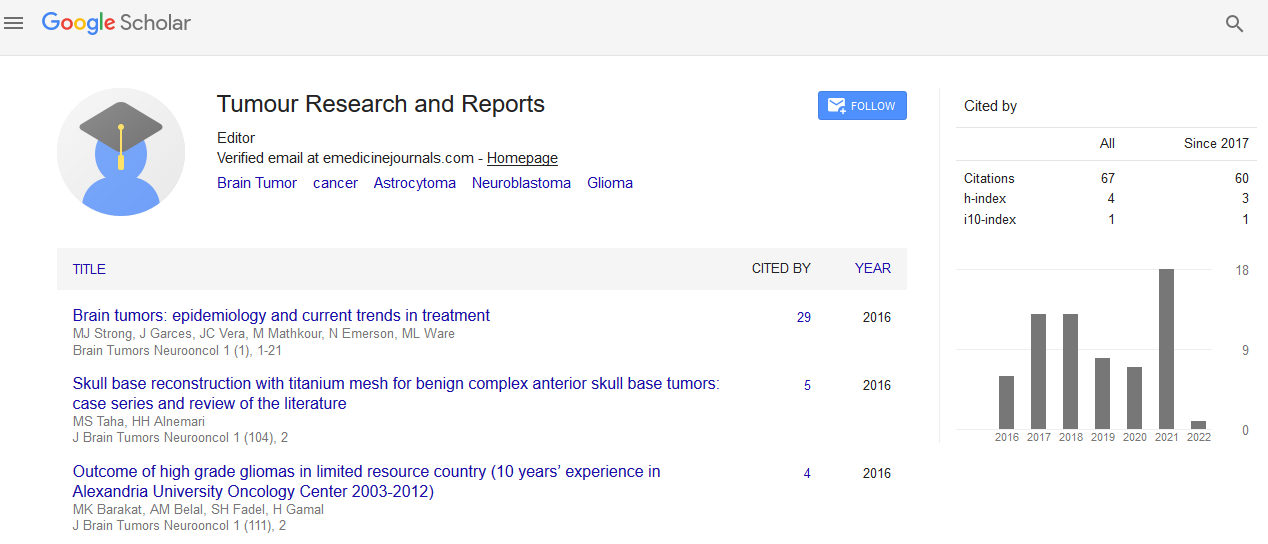Indexed In
- RefSeek
- Hamdard University
- EBSCO A-Z
- Google Scholar
Useful Links
Share This Page
Journal Flyer

Open Access Journals
- Agri and Aquaculture
- Biochemistry
- Bioinformatics & Systems Biology
- Business & Management
- Chemistry
- Clinical Sciences
- Engineering
- Food & Nutrition
- General Science
- Genetics & Molecular Biology
- Immunology & Microbiology
- Medical Sciences
- Neuroscience & Psychology
- Nursing & Health Care
- Pharmaceutical Sciences
Perspective - (2024) Volume 9, Issue 4
Enhancing Skin Cancer Awareness and Screening in Cancer Patients
Yan Hanzhang*Received: 29-Nov-2024, Manuscript No. JTRR-24-27827; Editor assigned: 02-Dec-2024, Pre QC No. JTRR-24-27827 (PQ); Reviewed: 16-Dec-2024, QC No. JTRR-24-27827; Revised: 23-Dec-2024, Manuscript No. JTRR-24-27827 (R); Published: 30-Dec-2024, DOI: 10.35248/2684-1614.24.9.242
Description
Skin cancer, primarily including basal cell carcinoma, squamous cell carcinoma and melanoma, is one of the most common types of cancer worldwide. While the survival rate for skin cancer is high, early detection and prevention play a major role in reducing both the incidence and mortality rates. Among cancer patients, who are often already navigating a complex medical landscape, understanding skin cancer risks and undergoing regular screening can be life-saving. This article describes the importance of improving skin cancer knowledge and screening among cancer patients, offering strategies for healthcare providers to enhance awareness and early detection.
Cancer patients, particularly those with a history of certain cancers or those who are immunocompromised due to treatment, are at higher risk for developing skin cancer. Treatments such as chemotherapy, radiation and immunotherapy can weaken the skin's ability to repair itself, making patients more vulnerable to skin malignancies. Furthermore, individuals with a family history of skin cancer or those who have had previous instances of sunburn or excessive UV exposure are at increased risk.
Despite these risks, skin cancer is often overlooked by cancer patients and healthcare providers alike. This can be attributed to a lack of awareness, misconceptions about the significance of skin health and the focus on treating the primary cancer. As a result, cancer patients may not routinely examine their skin or seek necessary dermatological care, increasing the likelihood of undiagnosed and untreated skin cancer.
Several factors contribute to the insufficient awareness and screening for skin cancer among cancer patients. Firstly, there is a lack of standardized protocols for skin cancer screening in oncology settings. While patients with certain types of cancers, such as melanoma, may be monitored more closely for skin abnormalities, others may not receive adequate attention.
Secondly, the busy healthcare system often limits the time available for patient education. Oncologists and other healthcare professionals may prioritize treatment for the primary cancer, inadvertently neglecting discussions about skin cancer. In addition, many patients, already burdened by the mental and physical toll of cancer treatment, may find it difficult to focus on preventive care for other health concerns, including skin cancer.
Moreover, misconceptions about skin cancer often prevail. Some patients may associate skin cancer primarily with fair-skinned individuals or those who have experienced sunburns, not realizing that the risk is present for all skin types and that UV radiation is not the only risk factor. This misunderstanding can lead to a lack of urgency in performing self-examinations or seeking professional evaluation.
Improving skin cancer knowledge and screening among cancer patients requires a multifaceted approach. Below are some essential strategies that can be implemented by healthcare providers:
Healthcare providers should integrate skin cancer education into the cancer care journey. This can include educating patients about the risk factors for skin cancer, how to perform regular self-skin exams and when to seek medical help for unusual changes. Providing printed materials, visual aids and even digital resources can ensure patients remember and act on the information.
Skin cancer screening should be routinely included in cancer care plans, especially for patients who are at higher risk due to their treatment or cancer history. Oncology clinics can work with dermatologists to establish a collaborative care approach, where regular skin checks are incorporated into the patient's treatment schedule. Early referral to a dermatologist for a fullbody skin exam can be life-saving.
For patients who are unable to visit dermatology clinics due to mobility issues, geographic barriers, or treatment schedules, telemedicine can serve as a valuable tool. Virtual consultations with dermatologists allow for preliminary assessments, skin monitoring and advice on when to seek in-person care. This can be particularly useful for cancer patients in remote areas or those with compromised health.
Conclusion
Improving skin cancer knowledge and screening among cancer patients is a essential step toward reducing the risk of late-stage skin cancer diagnoses. By increasing awareness, integrating regular screening into cancer care and addressing misconceptions, healthcare providers can help ensure that cancer patients receive comprehensive care that extends beyond the treatment of their primary cancer. With proactive screening and education, the potential for early detection increases, ultimately leading to better outcomes for cancer patients facing skin cancer risks.
Citation: Hanzhang Y (2024). Enhancing Skin Cancer Awareness and Screening in Cancer Patients. J Tum Res Reports. 9:242.
Copyright: © 2024 Hanzhang Y. This is an open access article distributed under the terms of the Creative Commons Attribution License, which permits unrestricted use, distribution, and reproduction in any medium, provided the original author and source are credited.

